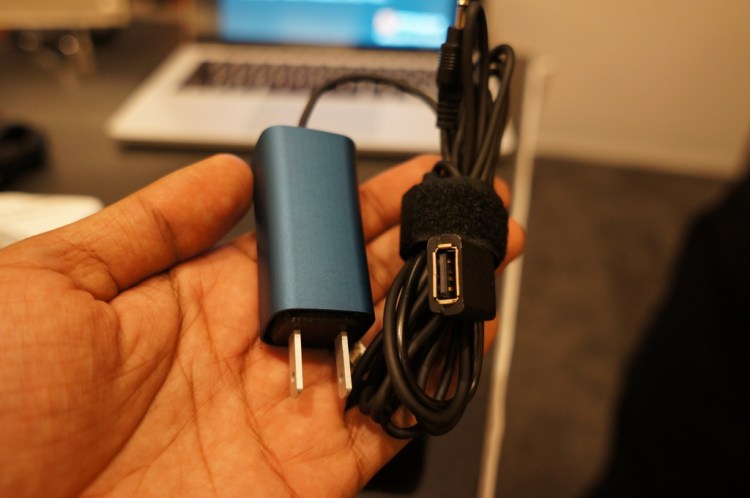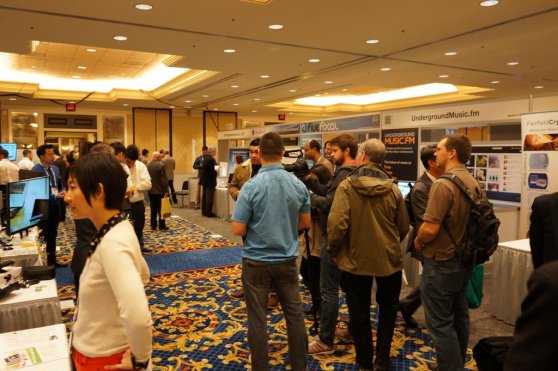At the 2014 International CES, I found a tiny laptop power adapter far more fascinating than any giant 4K TV.
The adapter comes from Finsix, a company I had never heard of before. While big-name TV makers had 4K sets to show off at one of the biggest tradeshows in the industry — tech that’s cool but isn’t a massive leap over our existing HDTVs — tiny startups like Finsix made up the lesser-seen CES.
These startups have tiny booths and little in the way of name recognition — but that doesn’t stop them from aiming big.
At the Venetian Sands expo, a short shuttle bus ride away from the CES main stage at the Las Vegas Convention Center, lies Eureka Park, the special startup “TechZone.” It’s quickly become one of the highlights of the show for me — so much so that VentureBeat formed a media partnership with the Consumer Electronics Association (which puts on CES) to highlight Eureka Park’s third year at the show.
Eureka Park was bigger this year and sported better companies, and as became increasingly clear throughout the show, it could just be CES’s ticket to staying relevant.
While big tech companies move to the tides of industry trends — this year it was things like 4K TV and wearable tech — startups follow their own beats. That doesn’t always lead to success (we saw plenty of potential duds this year), but it helps to diversify the ideas at CES — which can ultimately be a good thing when there aren’t any big tech innovations to show off.
Startups can also help CES better predict the upcoming industry trends. Last year’s crop of wearable gadgets, including the debut of Pebble’s long-awaited smartwatch and Fitbit’s first wristband gadget, came before we saw wearables take center stage this year, with companies like LG getting into the fray.
Finsix’s technology, in particular, struck me as the sort of thing that could have profound implications for the entire tech industry. While the company is targeting tiny laptop power adapters now, its power cycling tech could eventually help shrink the power bricks from plenty of other gadgets (just take a look behind your TV).
Oculus VR was yet another startup that continued to wow attendees at CES. It showed off the latest version of its Oculus Rift virtual reality headset, which included some significant improvements over the model it showed off last year (which was also one of our favorite things from last year’s show). Now flush with nearly $100 million in funding, Oculus is finally making the “virtual reality” an actual reality. It’s more than just more pixels on your TV, it’s a whole new way of experiencing media.
Sony showed off its own virtual reality headset at the show, but it was Oculus, a company that was only founded in 2012, that proved to the world first that true VR technology was within reach.
Throughout Eureka Park, we saw several companies with intriguing products: Mybell developed a connected bike bell, something that I’m shocked doesn’t exist already; TouchJet developed an interactive Android projector; and an Internet of things pioneer showed off his latest gadget, the creepy/cool Mother.
My colleague Dean Takahashi wrote about the Eureka Park startups including tablet-stand maker Nbryte, sleep-time teacher Sheepdog Sciences, puzzle-game maker Petros Media, child medical-vital sign detector Teddy the Guardian, smart dog-fitness collar FitBark, smartphone touch-sensitive fingernail maker Elektra Nails, and 36-image panoramic ball camera Panono.
It’s easy to get bogged down by the size of CES: Its show floor spans miles (2 million square feet of exhibit space), it crams far too many people (more than 150,000) into a city without the infrastructure to support them, and it’s often overflowing with industry hype rather than true innovation.
But Eureka Park feels different. It’s a rare part of the show where you have space to breathe and think. The crowds are here, too, but people are more interested in chatting about products than shoving past you to the next shiny thing.
While it may have begun as a way for CES to tap into the hot startup market, Eureka Park now feels as essential to the show as the giant tech companies. Nothing made that clearer to me than Eureka Park: Next, a special section for midstage startups that previously demoed at Eureka Park over the past two years.
They came back for a reason.
VentureBeat's mission is to be a digital town square for technical decision-makers to gain knowledge about transformative enterprise technology and transact. Learn More




